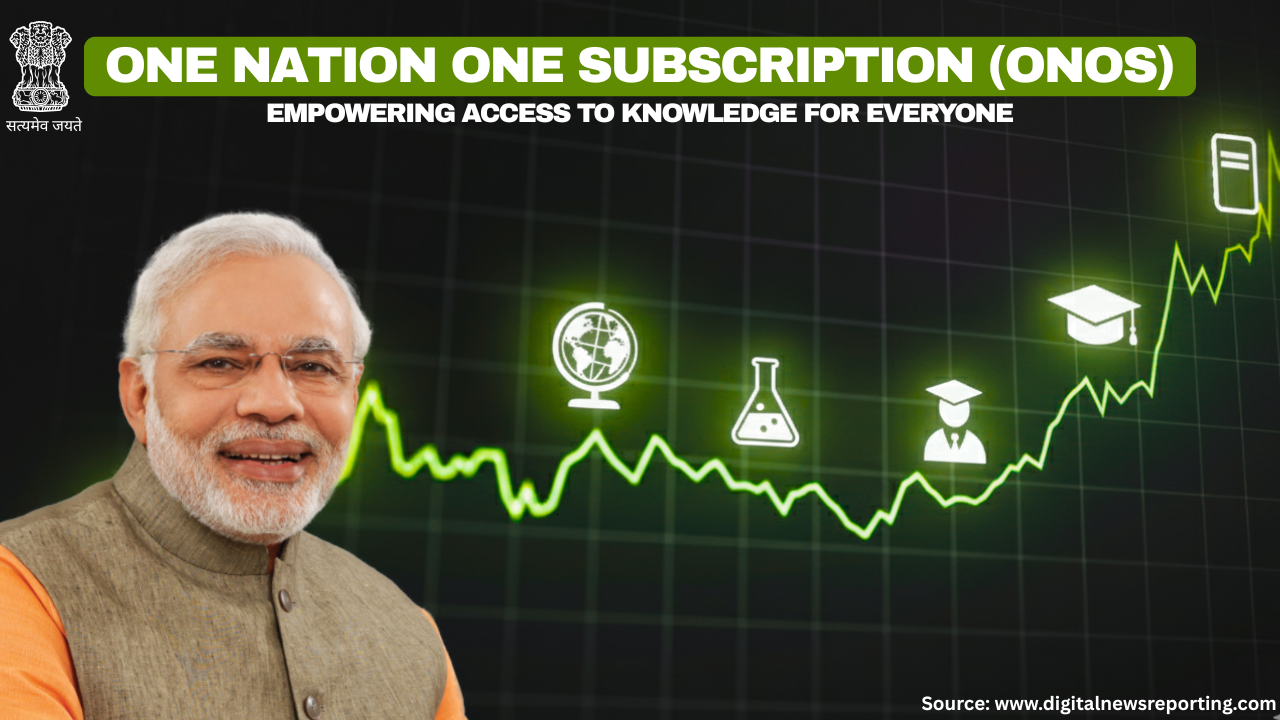The foundation of national progress rests upon the continuous pursuit of knowledge. Nevertheless, for decades, the intellectual development of India’s vast academic community has been constrained by a significant barrier: the prohibitive cost of accessing international scholarly journals. Libraries across the country, particularly in Tier 2 and Tier 3 institutions, have been caught in the “serial crisis” due to the rapidly escalating subscription fees demanded by global publishing conglomerates. This situation generated a profound “knowledge impediment,” hindering innovation and limiting the potential of millions of aspiring students and researchers.
- I. Analysis of the ONOS Model: What It Is and How It Operates
- II. The Transformative Power of Equitable Access (Benefits)
- III. Eligibility, Registration, and Access Protocols
- IV. The Way Forward (Challenges and Solutions)
- V. Conclusion: The Rise of a Knowledge-Rich India
- VI. Policy Highlights and Key Facts (For Quick Reference)
- VII. Information Sources and Policy Basis
- VIII. Frequently Asked Questions (FAQs)
In an historical decision to dismantle this expensive paywall, the Government of India launched the India One Nation One Subscription (ONOS) Central Sector Scheme (CSS). This one nation one subscription initiative is far more than a mere library reform; it represents a strategic national knowledge policy designed to democratize academic resources on an unprecedented scale. The ONOS scheme is a direct response to the Prime Minister’s call for “Jai Anusandhan” (Victory to Research), aligning completely with the core tenets of the National Education Policy (NEP) 2020 and the ambitious roadmap for a developed India, Viksit Bharat 2047.
This article presents an analysis of the ONOS operational mechanism, its immense benefits in strengthening the Indian Research Ecosystem, and the essential challenges that must be addressed for its long-term success.
I. Analysis of the ONOS Model: What It Is and How It Operates
At its core, the one nation one subscription india scheme signifies a monumental policy shift: moving from fragmented, costly individual subscriptions toward a single, unified national license. Instead of thousands of government institutions separately negotiating and paying for expensive journal access—a process that led to massive resource duplication and inefficiency—the government, through a designated central agency, negotiates one single, integrated subscription covering the entire eligible public academic sector.
This centralized approach to the one nation one subscription onos scheme grants India immense negotiating power, permitting the nation to secure access to a colossal reservoir of high-impact content at a considerably optimized cost compared to the aggregated expenditure of the past.
Key Features of ONOS (Phase I: 2025–2027)
| Feature | Description and Scale | Impact on Research Access |
| Scale | Over 13,000 full-text e-journals and research databases across STEM, Social Sciences, and Humanities. | Opens a “goldmine of knowledge” essential for multidisciplinary research in every government institution. |
| Partners | Agreements with 30 major global publishers, including giants such as Elsevier, Springer Nature, Wiley, and Taylor & Francis. | Ensures access to the world’s most high-impact, cited, and recent research studies. |
| Beneficiaries | An estimated 1.8 crore students, faculty, and researchers across the nation. | A substantial impetus for the equitable distribution of knowledge across the entire public academic sector. |
| Institutions | Over 6,300 Government (Central and State) Higher Education Institutions (HEIs) and Central Government R&D institutions. | Instantly levels the academic playing field by equalizing resource access nationwide. |
| Investment | A significant budget of an estimated ₹6,000 crore allocated for the initial Phase I (2025–2027). | Underlines the government’s serious, long-term commitment to advancing the Indian Research Ecosystem. |
| Management | The entire system is managed digitally and centrally by the Information and Library Network (INFLIBNET) Centre, an autonomous body under the UGC. | Provides a unified, user-friendly Academic Journal Access portal for improved management and accountability. |
The central role of INFLIBNET ensures that access is streamlined, providing a robust, accountable, and fully digital platform for all eligible users.
II. The Transformative Power of Equitable Access (Benefits)
The launch of ONOS is expected to have a profound impact not only on individual academic careers but also on India’s standing within the global scientific community.
A: Democratizing Research and Leveling the Playing Field
The most immediate and powerful benefit of ONOS is its contribution to genuine equitable access. By providing resources universally, the scheme effectively eradicates the historical knowledge gap between well-funded metropolitan universities and resource-constrained institutions located in rural or Tier 2/3 settings. Researchers in smaller colleges, who previously relied on outdated or unauthorized materials, now possess the same access to current, high-impact Academic Journal Access as their counterparts in premier central institutions. This empowerment of students and faculty in smaller HEIs is crucial for cultivating a grassroots Indian Research Ecosystem and ensuring that talent from every part of the nation has an equal opportunity to contribute to discovery.
B: Boosting India’s Global Research Footprint
Although India is recognized for the sheer volume of research output, its citation impact—a key metric for research quality and influence—often lags behind global leaders. This disparity is frequently linked directly to the historical difficulty researchers faced in accessing the exact journals that set global research standards.
By securing access to over 13,000 Global Journals, ONOS enables Indian researchers to:
- Engage with State-of-the-Art Methodology: Adopt the best practices and advanced techniques observed in top global papers.
- Produce High-Quality, Relevant Work: Base their findings on the most recent and highly cited literature, thereby increasing the probability of publication in high-impact international venues.
This enhancement in research quality and citation count will directly elevate India’s position in global academic rankings, establishing the country as a credible and formidable player on the world’s scientific stage—a necessary step toward achieving the objectives of Viksit Bharat 2047.
C: Financial Prudence and Cost Optimization
The economic model of ONOS offers a robust solution to the “Serial Crisis.” The high cost of journal subscriptions previously consumed a large portion of institutional library budgets. Through centralized negotiation, the government secures a massive, national-level bulk discount, resulting in considerable cost savings compared to fragmented, individual institutional spending. These significant funds saved by thousands of HEIs are now liberated for re-investment in other essential institutional needs, such as laboratory upgrades, improvements to local IT infrastructure, or the procurement of other non-journal academic materials.
D: Supporting Indian Authors and Open Access (OA)
The global academic publishing landscape is rapidly trending toward the Open Access (OA) model, which often shifts the cost from the reader (subscription) to the author via steep Article Processing Charges (APCs). A significant component of the ONOS scheme involves negotiating for discounts or even waivers of APCs for Indian researchers intending to publish their work in the high-quality OA journals of the participating publishers. This initiative substantially reduces the financial burden on Indian scholars, making it easier for them to contribute to their research globally and further amplifying the visibility and impact of the Indian Research Ecosystem.
III. Eligibility, Registration, and Access Protocols
The ONOS scheme is strategically designed to maximize public benefit, concentrating explicitly on institutions under governmental purview. Establishing appropriate registration and access protocols is paramount to scheme utilization.
A. Eligibility Criteria
The scheme is specifically designated for institutions under government management:
- Government Higher Education Institutions (HEIs): This includes all Central Government Universities, State Government Universities, their constituent colleges, and other HEIs under Central or State government control.
- Central Government R&D Institutions: Research and Development institutions managed directly by Central Government Ministries or Departments are also eligible.
In summary, all eligible institutions under the management of the Central or State Government and Central Government R&D Institutions are the direct beneficiaries of Phase I of the ONOS scheme. Private institutions are currently excluded.
B. Institutional Registration and Onboarding Process
All Government (Central as well as State) Higher Education Institutions and Central Government R&D institutions are confirmed as eligible participants in the one nation one subscription initiative. The formal mechanism for joining is as follows:
- Mandatory Registration: Eligible institutions are required to register via the official one nation one subscription portal to obtain necessary User ID and password credentials.
- Data Requirements: The new registration process necessitates the provision of the institution’s name, the mandatory All India Survey on Higher Education (AISHE) Code, and the contact details for the designated Institute Nodal Officer. This officer must be a regular, senior, and whole-time employee of the institution.
- AISHE Compliance: The AISHE Code is obligatory for registration. Institutions without this code must formally apply via the AISHE portal. Institutions are categorized as either a College/University (if they have students pursuing degrees/diplomas) or as an R&D institution (if focused purely on research).
- Authorization for R&D Institutions: R&D institutions without a student body must secure and submit an official letter authorizing their participation in ONOS from their parent Central Government Ministry or Department.
- Transition for Existing Users: Existing government consortia users, including state government HEIs possessing a static IP address, are being automatically ported to the ONOS portal to ensure a seamless transition of services. For specific assistance during this process, institutions may contact support@onos.gov.in, providing institutional name, designation, and Nodal Officer contact details.
C. Post-Registration Access Methods
Access to the ONOS resources is managed digitally through the INFLIBNET Centre and is designed to be seamless for authorized users:
- On-Campus Access: For institutions with a registered static IP address, access is automatic and granted campus-wide. Any computer or device connected to the institutional network immediately obtains access to the full suite of Global Journals.
- Off-Campus Access (INFED): For remote work, access is facilitated through the INFED Access Management Federation. Users obtain unique login credentials (user ID and password) from their institutional Nodal Officer/Librarian, allowing them to access content from any location within the country.
IV. The Way Forward (Challenges and Solutions)
Although the scheme’s launch is historical, its successful, long-term impact requires proactive strategies to address several logistical and structural challenges.
A: The Digital Infrastructure Hurdle
Challenge: Stable, high-speed internet connectivity is the prerequisite for accessing digital resources. In many remote and rural institutions, the Digital Divide persists, with unstable networks and power supply issues that compromise the utility of the ONOS platform.
Solution: This necessitates continuous, targeted investment in digital infrastructure, both at the national level (leveraging initiatives such as BharatNet) and at the institutional level. Colleges should dedicate resources to upgrading their internal networks to ensure a seamless experience for every student and faculty member.
B: Utilization and Capacity Building
Challenge: The value of the resource is nullified if it remains underutilized. Many users, particularly from smaller colleges, may lack the specialized expertise required to effectively search, filter, and utilize complex international databases.
Solution: INFLIBNET and the Department of Higher Education (DHE) must lead continuous, mandatory, and widespread training programs, workshops, and awareness campaigns. These capacity-building efforts are essential for ensuring the 1.8 crore beneficiaries understand how to maximize the platform’s research potential.
C: Financial Sustainability and the OA Shift
Challenge: Sustaining subscriptions in the long term is complex, given the persistent global increase in journal prices. Furthermore, adapting to the global Open Access (OA) trend demands a dynamic financial model, mitigating the risk of long-term dependence on a limited number of international publishers.
Solution: A robust, dynamic financial model is essential, involving regular, performance-based renegotiations guided by actual usage data. Strategic shifts toward sustainable models, such as “Publish and Read” agreements, will maintain access while aligning with the future of Academic Journal Access and mitigating long-term cost escalation.
D: Protecting and Promoting Indian Journals
Challenge: The heavy focus on international content, while necessary for global exposure, carries the risk of inadvertently overshadowing and reducing the financial viability of local, high-quality Indian journals.
Solution: A parallel policy focus is vital. This entails dedicated funding for domestic journals, improving their indexing standards, strengthening peer-review processes, and incentivizing Indian researchers to publish in and cite reputable domestic publications. Elevating the quality and visibility of Indian journals ensures that research rooted in local context also achieves national and global relevance.
V. Conclusion: The Rise of a Knowledge-Rich India
The India One Nation-One Subscription (ONOS) scheme constitutes a strategic investment in India’s future and human capital. It is a decisive measure that dismantles a systemic barrier, converting a fragmented, expensive knowledge ecosystem into a unified, equitable research powerhouse. By providing Academic Journal Access to over 13,000 Global Journals at scale, ONOS is prepared to empower the next generation of 1.8 crore researchers with the necessary tools to drive innovation and contribute significantly to Viksit Bharat 2047.
The ultimate success of this scheme is contingent upon collaborative effort: sustained financial commitment from the government, robust management from INFLIBNET to ensure digital access and training, and proactive utilization by every single eligible student and faculty member. ONOS is more than just a scheme; it is a declaration that knowledge is a national asset, ensuring that genius and discovery can flourish in every town and village across India.
VI. Policy Highlights and Key Facts (For Quick Reference)
This table summarizes the core factual and structural components of the One Nation One Subscription (ONOS) scheme, designed for rapid assimilation and recollection of policy essentials.
| Component | Key Fact / Metric | Significance |
| Scheme Name | One Nation One Subscription (ONOS) | A Central Sector Scheme (CSS) aimed at democratizing research access. |
| Implementation Agency | INFLIBNET Centre (Under UGC) | Centralized body responsible for negotiation, digital management, and access provision. |
| Policy Alignment | NEP 2020, Viksit Bharat 2047, “Jai Anusandhan” | Strategic initiative to boost national research output and quality. |
| Investment (Phase I) | ₹6,000 Crore | Allocation for the first three years, demonstrating significant financial commitment. |
| Phase I Duration | 2025–2027 (3 Calendar Years) | Initial phase duration for establishing the national license framework. |
| Research Coverage | Over 13,000 Global Journals | Massive repository of high-impact research across all major disciplines (STEM, Social Sciences). |
| Publisher Count | 30 Major International Publishers | Includes top global academic publishers (e.g., Elsevier, Springer Nature). |
| Beneficiaries | 1.8 Crore students, faculty, and researchers | Scale of population benefiting from equitable access to world-class resources. |
| Eligible Institutions | 6,300 Government HEIs & R&D Institutions | Focuses exclusively on government-managed entities (Central and State). |
| Access Methods | IP-based access (On-Campus) & INFED (Off-Campus) | Ensures seamless access both within institutional networks and remotely. |
VII. Information Sources and Policy Basis
he data, facts, and policy structure presented in this article are derived from official public documents and announcements released by the Government of India concerning the One Nation One Subscription (ONOS) scheme. The primary sources utilized for this analysis include:
- Ministry of Education (MoE) & Press Information Bureau (PIB) Releases: Official press notes and publications detailing the scheme’s approval, objectives, and investment (₹6,000 Crore) as approved by the Union Cabinet.
- The Official ONOS Portal: Data regarding institutional eligibility criteria, registration process (including the role of AISHE Code), and access management protocols (INFLIBNET, Nodal Officers).
- National Education Policy (NEP) 2020 and Viksit Bharat 2047 Vision: Contextual policy documents framing the strategic importance of democratizing research access in achieving national development goals.
- INFLIBNET Centre Documentation: Information regarding the operational scale, publisher count (30 major global publishers), and technical access mechanisms (INFED).
VIII. Frequently Asked Questions (FAQs)
What is ONOS?
The One Nation One Subscription (ONOS) scheme is a Central Sector Scheme launched by the Government of India to acquire a single, consolidated national license for over 13,000 high-impact international e-journals and research databases. This initiative aims to provide universal and equitable Academic Journal Access to all eligible government-managed higher education and R&D institutions across the nation.
Who is eligible under ONOS?
All government-managed institutions are eligible, including Central Government and State Government Higher Education Institutions (HEIs) (universities, colleges) and Central Government Research & Development (R&D) institutions. Private institutions are generally excluded from Phase I.
Are private universities or colleges eligible to participate in ONOS?
No, as per the current scope of Phase I (2025-2027), the scheme is explicitly designed as a Central Sector Scheme covering only institutions under the management of the Central or State Governments of India.
What types of resources are available through ONOS?
The scheme provides access to over 13,000 full-text e-journals and databases published by 30 major international academic publishers, covering diverse disciplines including Science, Technology, Engineering, Medicine (STEM), Social Sciences, and Humanities.
Who can access the resources provided by ONOS?
Access is primarily granted to the students, faculty, and researchers (including UG, PG, Doctoral, and Post-doctoral scholars) of the eligible and registered government institutions. School students (e.g., 10th or 12th grade) are generally not eligible unless they are formally enrolled in an eligible HEI program or are engaged in research activities within a participating R&D institution under a specific, formal capacity.
How can an institution become a member of ONOS?
Eligible institutions must register through the official one nation one subscription portal. The process requires the institution’s name, the mandatory AISHE Code, and the contact details of a designated, senior, whole-time Institute Nodal Officer.
How can institutions obtain the AISHE Code if they do not have it?
The AISHE Code is mandatory for registration. Institutions without it must apply through the AISHE portal. Institutions are categorized based on their function (College/University if they have students pursuing degrees/diplomas, or R&D institution if research-focused).
How is access to ONOS resources managed?
Access is centrally managed by the INFLIBNET Centre through a unified portal. Access methods include IP-based access (automatic on-campus) and off-campus access via INFED, utilizing institution-provided user credentials.
What is INFED?
INFED (Identity Federation) is an Access Management Federation set up at the INFLIBNET Centre. It facilitates secure, authenticated off-campus access to ONOS e-resources, allowing authorized users to access the content remotely using their institutional credentials.
How can the Institute set up off-campus access?
Off-campus access is facilitated by the central INFED setup maintained by INFLIBNET. The Institute’s Nodal Officer or Librarian manages user accounts and provides the necessary user IDs and passwords to authorized institutional members.
How can institutions manage their IP ranges for access?
For institutions utilizing static IP addresses, the IP ranges must be submitted and managed through the ONOS portal. This process ensures seamless, automatic on-campus access to the subscribed resources.
What should be done if a required journal is not accessible?
If a journal is required but is not accessible, it typically means the journal is not included within the agreements of the 30 publishers in Phase I. Institutions must continue to independently procure subscriptions for resources not covered by the ONOS national license.
What do member institutions need to access e-resources through ONOS?
Institutions require a stable internet connection, a registered AISHE Code, and either a registered static IP address for on-campus access or user credentials issued by the Nodal Officer for INFED off-campus access.
Is individual membership available for ONOS?
No, ONOS is an institutional scheme. Membership and access are provided only through the eligible and registered Central or State Government Higher Education Institutions and R&D institutions. Individual access is not permitted.
What should I do if I receive an “IP overlapped” message while submitting my IP address on the ONOS portal?
An “IP overlapped” message indicates that the submitted static IP address range conflicts with a range already registered by another participating institution. The institution should contact the support team via email at support@onos.gov.in to resolve the conflict and correctly register their unique IP range.
Whom should I contact for further details?
For specific assistance, institutions should first contact their designated Institute Nodal Officer. If further technical or registration support is required, inquiries may be directed to the dedicated support channel at support@onos.gov.in.







